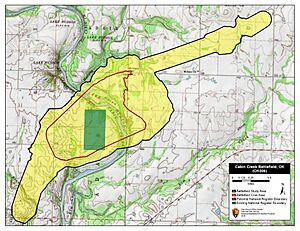First Battle of Cabin Creek facts for kids
The First Battle of Cabin Creek happened on July 1 and 2, 1863, in what is now Mayes County, Oklahoma. This battle was part of the American Civil War. Confederate forces, led by Colonel Stand Watie, tried to surprise and attack a Union supply convoy. This convoy was bringing important supplies to Fort Gibson.
The Union convoy was led by Colonel James Monroe Williams. He found out about the planned attack. Even though the creek was flooded from rain, Williams successfully attacked the Confederates. They were dug into their positions, but the Union forces made them run away.
This battle was important for a few reasons. It allowed the Union to win the Battle of Honey Springs later that month. It was also the first time that African American soldiers fought side-by-side with white soldiers in the war.
Two battles happened at the Cabin Creek battlefield in the Cherokee Nation (part of Indian Territory back then). This area was where the Texas Road crossed Cabin Creek, near today's town of Big Cabin, Oklahoma. Both the First and Second Battles of Cabin Creek were Confederate attempts to stop Union supply trains.
The second battle, in September 1864, was another Confederate raid on a Union supply train. The Confederates captured a lot of mules, wagons, and supplies. But this happened too late in the war to change the overall outcome. Confederate General Stand Watie led the attacks in both battles.
Quick facts for kids First Battle of Cabin Creek |
|||||||
|---|---|---|---|---|---|---|---|
| Part of the Trans-Mississippi Theater of the American Civil War |
|||||||
|
|||||||
| Belligerents | |||||||
| Commanders and leaders | |||||||
| James Monroe Williams | Stand Watie | ||||||
| Strength | |||||||
| Detachments from nine units | 1,600–1,800 | ||||||
| Casualties and losses | |||||||
| 3–23 killed, 30 wounded | 65 killed | ||||||
Why the Battle Happened
Colonel James M. Williams was in charge of protecting a Union supply train. This train was traveling from Fort Scott, Kansas to Fort Gibson, Oklahoma. At that time, Oklahoma was called Indian Territory.
His group marched along the Texas Road. It included soldiers from several different units. These were the 2nd Colorado Infantry Regiment, 3rd Wisconsin Volunteer Cavalry Regiment, 6th Regiment Kansas Volunteer Cavalry, 9th Regiment Kansas Volunteer Cavalry, 3rd Regiment, Indian Home Guard, 1st Kansas Colored Infantry, and the 2nd Kansas Artillery.
Confederate Colonel Stand Watie planned to ambush Williams's convoy. Watie had between 1,600 and 1,800 men waiting at the Cabin Creek crossing. Watie had hoped for 1,500 more men to join him. These extra troops were led by Brigadier General William L. Cabell. However, Cabell's soldiers were delayed because the Grand River had very high water levels.
The Battle at Cabin Creek
When Williams arrived at the creek crossing on July 1, he learned about Watie's plan. He got this information from Confederate soldiers his men had captured. Watie's battle line stretched for about a mile on both sides of the crossing. His men were hidden in trenches dug into the bushes along the creek.
The creek had unusually high water, reaching above shoulder height. Because of this, Williams decided to wait until the next day to attack the Confederates. He gathered his wagons into a defensive circle on a nearby open field.
The next day, Williams ordered his artillery to fire for half an hour. After this, he sent the Third Indian Home Guard to attack. But they couldn't get across the creek, which was now waist-deep. Heavy Confederate fire pushed them back.
Then, the Ninth Kansas Cavalry was ordered to charge. The 1st Kansas Colored Infantry provided covering fire for them. Once the cavalry made it across the creek, Williams led his own regiment, the 1st Kansas Colored Infantry. They charged across the stream and into the bushes. This forced the Confederates to retreat. Williams chased them for a quarter of a mile as they tried to regroup in a clearing.
After the battle, Williams successfully led his convoy to resupply Fort Gibson. The Confederates lost 65 men. The Union Army had between 3 and 23 soldiers killed, and 30 were wounded.
Why This Battle Mattered
This battle was very important for the Union. It allowed them to keep a strong presence in the Indian Territory. This led to later Union victories at Honey Springs and Fort Smith.
Soon after the battle, the Union set up defensive outposts along the Texas Road. One of these was at the Cabin Creek crossing itself. This battle is also special because it was the first time that African American soldiers (from the 1st Kansas Colored Infantry) fought alongside white troops. A monument to the 1st Kansas Colored Infantry was put up on the battlefield on July 7, 2007.
Images for kids



